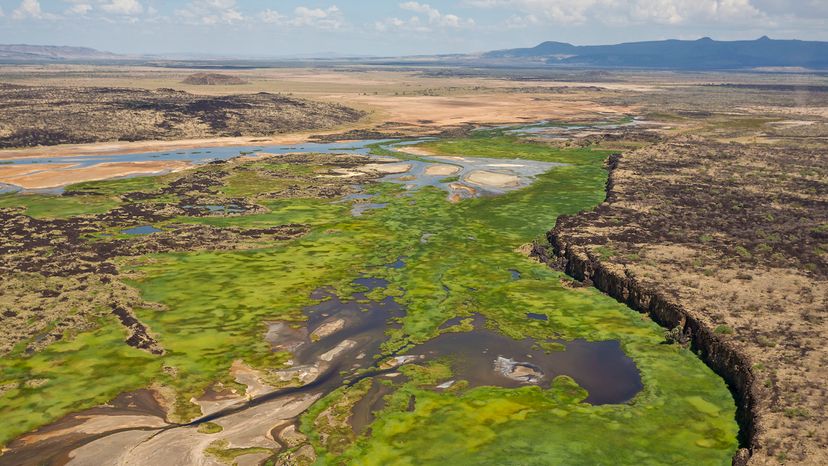By: Clarissa Mitton|Mar 19, 2024

In the heart of East Africa, a seismic event is unfolding that could forever alter the continent's geographical landscape. The notion of Africa splitting has the attention scientists and geologists worldwide, as the Great Rift Valley stretches and tears at the Earth's crust.
This dramatic phenomenon is not the plot of a science fiction novel but a real and ongoing process that may lead to the birth of a new ocean, reshaping Africa's boundaries over millions of years.
Contents
- The Great Rift Valley
- Understanding Plate Tectonics
- Evidence of the Split
- What a Split Continent Means for Africa
- Comparing Africa's Rift With Other Geological Phenomena
- What Is Causing the Somali and Nubian Plates To Split?
The Great Rift Valley
The Great Rift Valley, which stretches from the Afar region down to Mozambique, offers breathtaking landscapes and is crucial for understanding the forces shaping our planet.
At the heart of this vast depression lies the East African Rift System (EARS), a zone where the African continent is slowly being torn apart. This site has attracted attention because a large crack recently made a sudden appearance in southwestern Kenya.
Advertisem*nt
Understanding Plate Tectonics
Plate tectonics, the theory that explains the movement of the Earth's lithosphere, is central to understanding the division of the African continent.
The East African Rift System is a prime example of divergent tectonic plates pulling away from each other, with the African plate now appearing to be two separate entities — the Somalian tectonic plate and the larger Nubian tectonic plate — moving in opposite directions.
Advertisem*nt
This tectonic activity not only contributes to the possible formation of Earth's sixth ocean but also reshapes the geography of East Africa, echoing the processes that once separated the vast protocontinent, Pangea, to form the Atlantic Ocean.
If the Nubian and Somali plates continue to drift, countries like Uganda and Zambia may have their own coastlines in the future.
Advertisem*nt
Evidence of the Split
Recent geological surveys and satellite imagery have provided compelling evidence of the African continent's slow but steady split. These observations confirm the active splitting of the continent, as the East African Rift gradually widens.
It's important to note that while this discovery is exciting, the rifting process will take tens of millions of years to completely split. To put it into perspective, currently, the plates are diverging at an average rate of 0.2 inches (7 millimeters) per year.
Advertisem*nt
While the rift is currently above sea level, over time, it will widen and the crust will thin and sink. Eventually, a small seaway will begin to invade the rift zone, much like the Red Sea, transforming the geography of the region and creating its own separate small continent.
What a Split Continent Means for Africa
The potential split of the African continent carries significant implications for its future. As the East African Rift Valley continues to expand, it could lead to the creation of an ocean basin, fundamentally altering the region's environment and climate.
This transformation could affect biodiversity, water resources and agricultural practices, posing both challenges and opportunities for the inhabitants of East Africa.
Advertisem*nt
Moreover, the gradual separation might influence the continent's geopolitical landscape, as new maritime routes emerge and nations reassess their territorial boundaries. It may even create new opportunities for trade and communication.
Comparing Africa's Rift With Other Geological Phenomena
While this geological phenomenon may seem revolutionary to some, it's actually quite common. If you look at a map, you'll quickly see how Africa and South America appear to fit perfectly together. This is because they were once a landmass. Over time, the land was split by the Mid-Atlantic Ridge.
Advertisem*nt
What Is Causing the Somali and Nubian Plates To Split?
While experts have known that Africa is splitting in two for a while, pinpointing the exact cause has been a struggle.
A wide zone of seismic activity and evidence now suggests the rift is caused by a superplume upwelling along the eastern edge of Africa. Ultimately, the sudden appearance of the crack may be due to heavy rainfall in the area.
Advertisem*nt
We created this article in conjunction with AI technology, then made sure it was fact-checked and edited by a HowStuffWorks editor.
Cite This!
Please copy/paste the following text to properly cite this HowStuffWorks.com article:
Citation
Advertisem*nt
Advertisem*nt
Loading...
\n\n\t\t\t\t
`;t.byline_authors_html&&(e+=`By: ${t.byline_authors_html}`),t.byline_authors_html&&t.byline_date_html&&(e+="|"),t.byline_date_html&&(e+=t.byline_date_html);var i=t.body_html.replaceAll('"pt','"pt'+t.id+"_");return e+=`\n\t\t\t\t
\n\t\t\t\t
\n\n\t\t\t\t
${i=i.replaceAll("#pt","#pt"+t.id+"_")}
\n\n\t\t\t
`}(a);this.loadedDiv.innerHTML+=n,document.title=a.title+" | HowStuffWorks";let s="content-loaded-"+a.id,l=document.getElementById(s);l.dataset.contentId=a.id;let o=l.querySelectorAll(".lazyload");HSW.utilities.lazyLoadElements(o),HSW.ux.editorial.init({twitter:!0,facebook:!0,instagram:!0}),l.querySelectorAll(".toc a").forEach(t=>{t.addEventListener("click",t=>{t.preventDefault();let e=t.target.dataset.target,i=document.querySelector("a[name='"+e+"']");i?i.scrollIntoView({behavior:"auto"}):console.error("Unable to locate target with name "+e)})});try{if(userData.adsActive)if(HSW.utilities.isMobile()){l.querySelectorAll(".ad-mobinline").forEach(t=>{t.setAttribute("id","ad-wrap-mobinline"+r),t.childNodes[0].setAttribute("id","ad-div-mobinline"+r),void 0!==HSW.ads&&HSW.pq.add(()=>{HSW.ads.addNewUnits(["ad-div-mobinline"+r])},"ads"),r++})}else{let t=document.createElement("div");t.setAttribute("id","ad-after-"+e),t.classList.add("ad-inline","mb-8","bg-gray","w-max-full","h-min-90","text-center");let a=document.createElement("div");a.setAttribute("id","ad-div-inline"+i),t.appendChild(a),l.after(t),void 0!==HSW.ads&&HSW.pq.add(()=>{HSW.ads.addNewUnits(["ad-div-inline"+i])},"ads")}}catch(t){console.error(t)}if(window.setupSinglePageUX(l),history.pushState)try{history.pushState(null,a.title+" | HowStuffWorks",a.href)}catch(t){console.warn(t)}var c=[];a.taxonomy.forEach((t,e)=>{c[e]=t.title.toLowerCase()});var d=c.join("/"),h=[];a.authors.forEach((t,e)=>{h[e]=t.first_name.toLowerCase()+" "+t.last_name.toLowerCase()});var g=h.join(",");pageMetricsData.href=a.href,pageMetricsData.title=a.title,pageMetricsData.tax=d,pageMetricsData.aType=a.asset_type,pageMetricsData.cType=a.type+"-continuous",pageMetricsData.template=a.template,pageMetricsData.source=a.source,pageMetricsData.sponsor=a.sponsor,pageMetricsData.author=g,pageMetricsData.contentid=a.id,pageMetricsData.image=a.hero_image,pageMetricsData.page=0,pageMetricsData.pubDate=a.publish_date.slice(0,10),pageMetricsData.editDate=a.last_editorial_date.slice(0,10);const u=/[^\da-z_]/i;let p=HSW.utilities.isMobile()?"hsw_lite":"hsw";a.taxonomy.slice(1,3).forEach((t,e)=>{p+="|"+t.title.replace(u,"").toLowerCase()}),pageMetricsData.adUnit=p,Alpine.store("share",{title:pageMetricsData.title,url:pageMetricsData.href,image:pageMetricsData.image}),function(t,e){let i=t.href.split(".com/").pop();dataLayer.push({event:"virtual-page-view",virtualPageUrl:i,virtualPageTitle:document.title,pageNbr:0}),dataLayer.push({event:"raw-event-interactive",eventCategory:"page-interaction",eventAction:"continuous-load",eventLabel:"new-content",eventValue:e+1,virtualPageUrl:t.href})}(a,this.items.length);const m={...pageMetricsData};t.items.push(m);for(var f=document.getElementsByClassName("new-content-loaded"),v=0;v